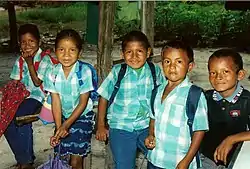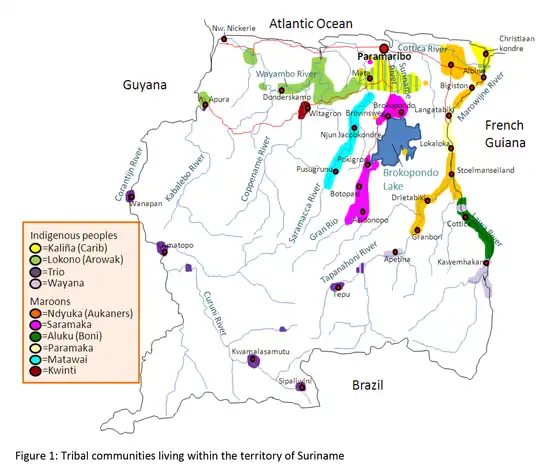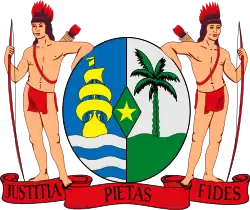 Schoolchildren of the Kali'na community at Bigi Poika in Suriname. | |
| Total population | |
|---|---|
| ~12,000–24,000 3.7% of Suriname's population[1] | |
| Regions with significant populations | |
| Paramaribo, Wanica, Para, Marowijne, Sipaliwini | |
| Languages | |
| Akurio, Arawak-Lokono, Carib-Kari'nja, Sikiana-Kashuyana, Tiro-Tiriyó, Waiwai, Warao, Wayana, Dutch, Sranan Tongo, English | |
| Religion | |
| Native American religion, Christianity (Catholicism and Protestantism), others |
Indigenous peoples in Suriname, Native Surinamese, or Amerindian Surinamese, are Surinamese people who are of indigenous ancestry. They comprise approximately 3.5% of Suriname's population of 612,985.
Contemporary groups
- Akurio, Tapanahoni and Sipaliwini rivers, Kwamalasamutu[2]
- Arawak (Lokono), Suriname, French Guiana, Guyana, Venezuela[2]
- Kalina, Brazil, Guyana, French Guiana, Suriname, Venezuela[2]
- Mawayana[2]
- Saloema (Taruma), Kwamalasamutu on Sipaliwini river, Brazil, Guyana[3]
- Sikiana, Kwamalasamutu on Sipaliwini river, Brazil[2]
- Tiriyó, Tapanahoni River, Sipaliwini River, Brazil[2]
- Waiwai (Uapixana, Vapidiana, Wapichan, Wapichana, Wapisana, Wapishshiana, Wapisiana, Wapitxana, Wapixana), Amazonas, Brazil, Suriname and Guyana[2]
- Warao (Guarao, Guarauno, Warau, Warrau), Venezuela, Guyana and Suriname[2]
- Wayana, Southwest Marowijne District, upper Tapanahoni river, Brazil, French Guiana[2]
Distribution

Distribution of indigenous and Maroon peoples in Suriname
See also
Notes
- ↑ "Suriname." CIA World Factbook. Retrieved 8 Dec 2013.
- 1 2 3 4 5 6 7 8 9 "Suriname." Ethnologue. Retrieved 8 Dec 2013.
- ↑ Peter Rivière (1981). "A Report on the Trio Indians in Suriname". New West Indian Guide. The Hague: Nijhoff Publishers. p. 2.
This article is issued from Wikipedia. The text is licensed under Creative Commons - Attribution - Sharealike. Additional terms may apply for the media files.

.svg.png.webp)